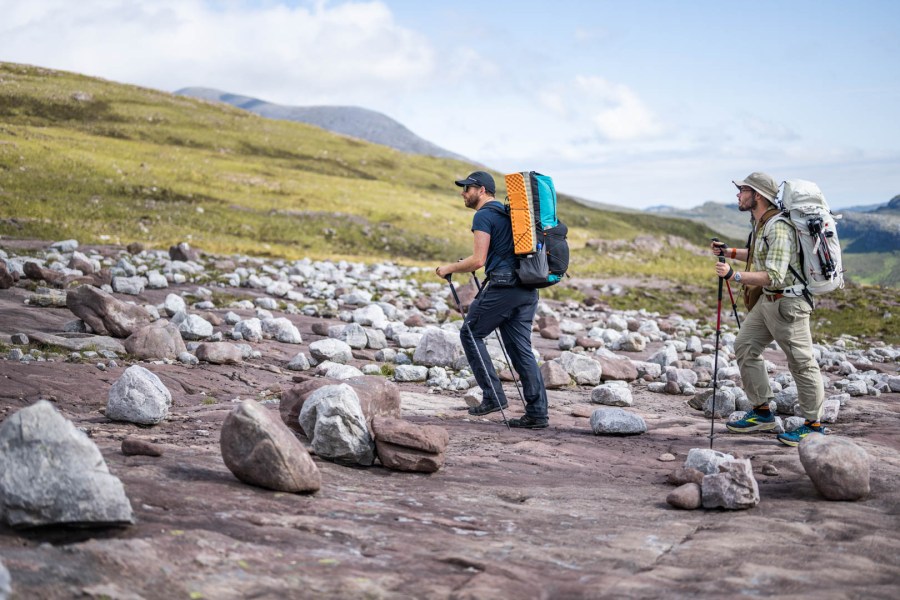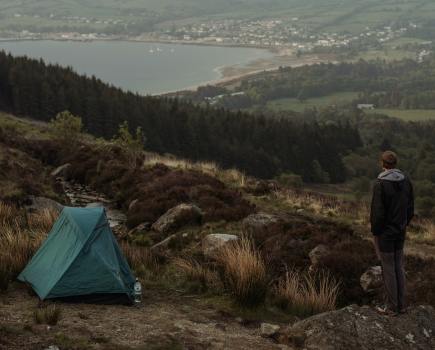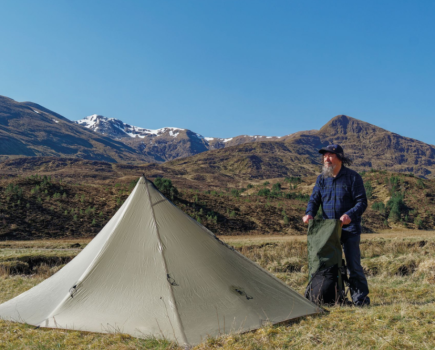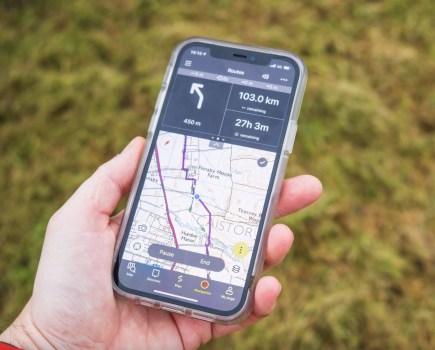The Great Outdoors’ team review the latest and best backpacking packs of 55 to 65L.
These backpacks are in the 55 to 65 litre grouping and are designed for backpacking, as opposed to daytrips, outings where you need to carry a shelter, sleeping bag and mat, a stove, food and spare clothing. The best backpacking packs and their contents can make or break any backpacking trip. Poorly balanced packs that don’t fit you – or your gear – are not only uncomfortable but could potentially be dangerous.
Your pack should fit your body shape well and be big enough to carry the load. We recommend you try packs on in person to find one that fits your shoulders, back length and hip measurements well. A pack should be fitted so that most of the weight is carried on the hips. If you are shopping online, it’s important that you take accurate measurements – or get someone to help you do so. While many packs are made adjustable, not all adjustability is made equal.
Different people want different things in a pack. Some are looking to shave weight, and so a smaller or frameless pack may be attractive. Others are looking for more comfort at camp after you’ve pitched your tent, or breathability while walking, and might opt for a larger capacity or a suspension back system to suit. Carefully consider the materials the pack is made of – some fabrics are more abrasion or water resistant, while others (like mesh, for example) allow the water to drain fast but are prone to snagging.
How your gear is organised is also important. Many travel or expedition-orientated packs come with several built-in compartments, which can either be useful, or confusing depending on your preference – and they will also add weight. Hipbelt pockets can be useful to keep phone, camera and snacks to hand. Side pockets are useful for water or fuel bottles, tent poles and the like. A lid pocket is useful for lunch, a map or other navigation tools, perhaps goggles or gloves. Having all these to hand means you are more likely to use them, but lots of external pockets can become a nuisance on very steep or technical ground. You can learn more about how to pack a backpack from Chris Townsend’s expert skills advice in The Great Outdoors magazine. This test includes a world-first: a pack designed specifically for plus-sized hikers. This speaks to how pack innovations are increasingly accommodating for all body shapes and sizes and the differences between the backpacking needs of men and women.
The best backpacking packs
Here’s our list of the best backpacking packs. We’ve looked some of the best backpacks for both men & women with bags featuring from the likes of Sierra Designs, Gregory, Mountain Laurel Designs and more. To find out more about each pack, please see their full reviews.
Sierra Designs Flex Capacitor 40-60L
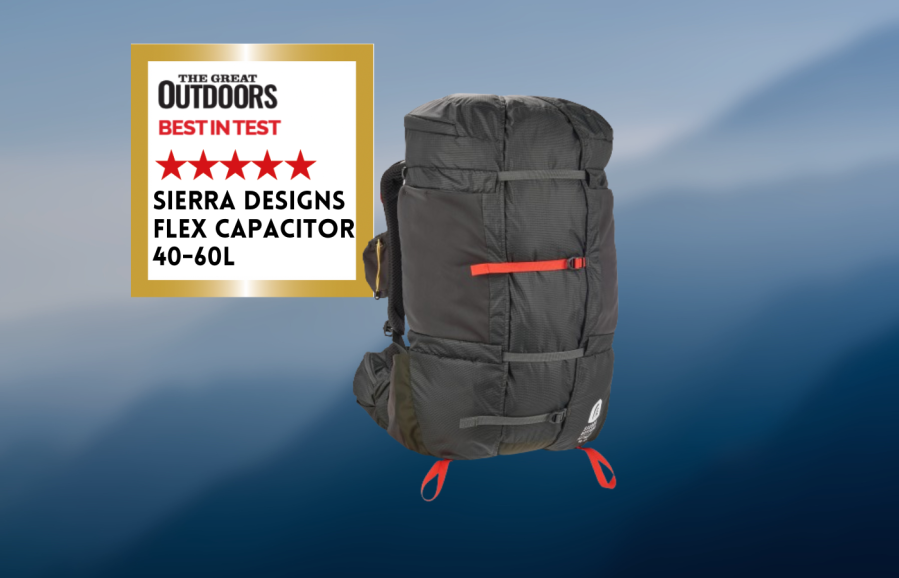
Chris Townsend’s Best In Test
The latest version of the Sierra Designs Flex Capacitor has the same back system as before but a redesigned, and in my opinion improved, packbag.- Expandable Volume
- Pockets
- Load carrying ability
- Lightweight
- Cost
- Lid can’t be raised or compressed for different sized loads
| Quick specs | |
|---|---|
| Price: £180 Weight: 1.265kg (S/M) Capacity: 40-60 litres Materials: 100D Nylon Honeycomb/420D Oxford Nylon Closure: zipped lid Back: Y-shaped tubular frame, padded scapular and lumbar pads Hipbelt: padded, shaped Pockets: 2 stretch mesh front, 2 stretch mesh side, 2 stretch mesh shoulder strap, 2 zipped, hipbelt, 1 zipped lid, inner hydration sleeve Features: Expandable gusset, side/front straps, ice axe loops Sizes: S/M. M/L Women’s/Men’s Version: No URL: https://sierradesigns.com |
The Flex Capacitor backpacking pack has been a favorite for six years, with the latest version featuring a redesigned and improved packbag. The pack has a rigid curved Y-shaped frame, thick mesh-covered foam pads, and an air gap for ventilation. The hipbelt is wide and well-padded, and it can handle 20kg loads. The packbag has a central gusset with four straps for variable capacity, which is more efficient than extending the pack upwards. The long straps can be used to attach a foam pad to the back of the pack. New features include big stretch pockets on each side of the gusset, smaller mesh pockets for water bottles, zipped hipbelt pockets, stretch shoulder strap pockets, and a zipped lid pocket. The U-shaped zip-round lid allows quick access to the contents, but it cannot be raised or tightened when the pack is not full. Despite this, the Flex Capacitor is lightweight, comfortable, and tough, and comes at an excellent price.
Read Chris Townsend’s full Sierra Designs Flex Capacitor 40-60L Backpacking Review
Atom Packs The Mo 60
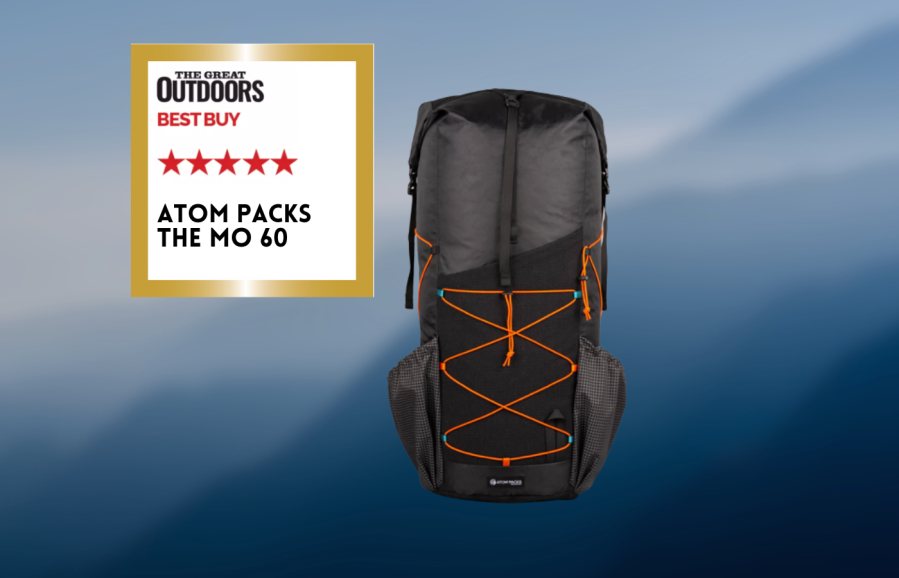
Chris Townsend’s Best in Test
In our tests, the Mo VX60 pack was superb, handling loads extremely well while feeling comfortable to wear. It was also remarkably light to carry but also offered capacious storage.- Durable
- Light
- Well-crafted
- None
| Quick specs | |
|---|---|
| Price: $310 | £285 Weight: 930g Capacity: 60L Materials: Ecopak EXPX200, 210D Robic Extreema pockets, straps and hipbelt, Dyneema mesh, 500D nylon back panel | Closure: rolltop Back: fixed length Hipbelt: cushioned, adjustable, 4 inches Pockets: two stretch mesh on harness, two side pockets, 5L front pocket Sizes: S, M, L, XL and various hipbelt sizes Men’s version: unisex |
Atom Packs was created by Tom Gale, an experienced long-distance hiker who has completed the Appalachian, Pacific Crest, and Continental Divide Trails in the USA and the Te Araroa in New Zealand. The particular model that I tested is one of the latest from the brand and is capable of managing loads of up to 19kg. It features a durable but lightweight fabric, a 4-inch wide adjustable hipbelt, EVA foam lumbar pad, removable closed cell foam back panel and various pockets. In our tests, the Mo VX60 pack was superb, handling loads extremely well while feeling comfortable to wear. It was also remarkably light to carry but also offered capacious storage. This pack can be customised, so there’s potential control over fabrics, colours, and features.
Read Chris Townsend’s Atom Packs Mo EP50 review.
Salewa Alptrek 50+10
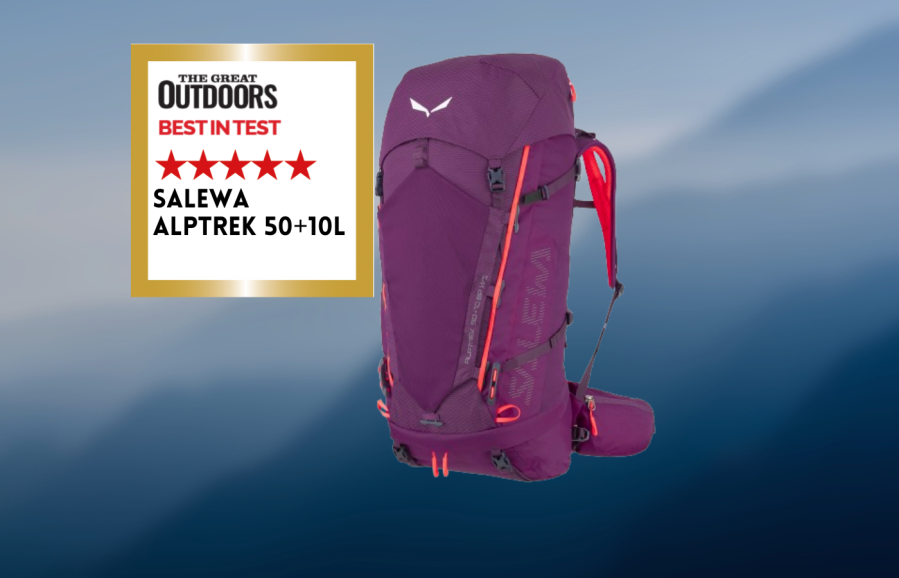
Fiona Russell’s Best in Test
The Salewa Alptrek 50+10 Backpack is ideal for a slimmer female and it felt immediately comfortable with a medium thickness of padding at the rear, hipbelt and shoulders.- Slim fit
- Female Design
- Comfort
- Pockets
- Raincover
- Hipbelt pockets
- fiddly lid
- Vague Eco Info
| Quick specs | |
|---|---|
| Price: £210 Weight: 1780g Capacity: 50 + 10 litres Materials: 100Dx280D Nylon Twill and 210D Nylon Honeycomb Closure: Detachable lid, drawstring top Back: Internal frame, EVA pads with 3D channel ventilation Hipbelt: Adjustable padded “split” hip belt Pockets: Side zip to main compartment, large zipped front pocket, 2 zipped lid pockets, front net pocket, 2 side net pockets, zipped lower compartment, hydration sleeve, 2 hip belt pockets, zipped pocket for raincover Features: S, M, L torso adjustment, side compression straps, trekking pole fastening, double ice axe fastening, rope fastener, raincover, 2 x daisy chain loops Sizes: one size (45-53cm torso) Women’s/Men’s Version: no URL: https://www.salewa.com/en-gb |
The Salewa Alptrek 50+10 Backpack is a comfortable and compact option for slimmer females. It features medium padding at the rear, hipbelt, and shoulders, with a cut-out design for a customized fit. The pack is one of the smaller on test, but can be expanded by removing the lid and adding more items. A rain cover is included for waterproofing. The main compartment has a top and side zip, a lower zipped compartment for sleeping bags, and a zipped divider for versatility. The pack has a large, zipped side pocket, three external stretch pockets, and two more zipped pockets in the lid. Despite being one of the heaviest on test, the pack feels compact and evenly weighted when fully packed. Some niggles include a sticky zip on the lower main compartment and a fiddly detaching/attaching system for the lid. The pack is made with a “Salewa Committed” icon, indicating its sustainability.
Read Fiona Russell’s full Salewa Alptrek 50+10 Backpack Review
Gregory Packs Amber Plus Size 65l
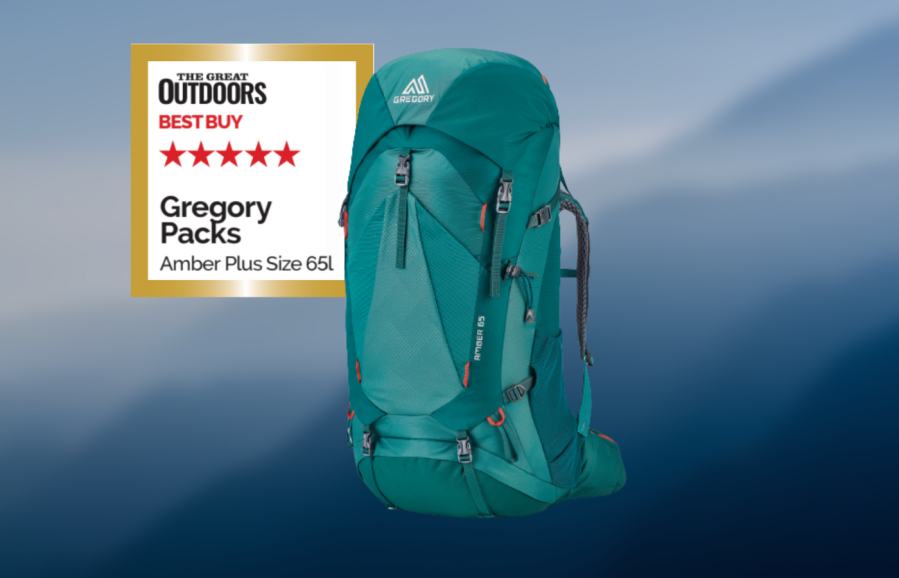
Francesca’s Best in Test
This pack is so comfortable and well-equipped, it’s worth its weight.- Weight-to-comfort ratio
- Storage
- None
| Quick specs | |
|---|---|
| RRP: $239.95 | £200 Weight: 1613g (one size) Capacity: 65l Materials: Body: 210D nylon, 420D high-density nylon. Base: 840D Ballistic Polyester. Harness/Hipbelt/Lumbar: multi-density closed and open cell foams. Chasis Support: Alloy Steel Frame. Lining: 40% Post-consumer Recycled 135d Polyester with Pfc-free Dwr Closure: Quick-pull drawcord closure and top webbing compression with floating zippered lid Back: Wishbone alloy frame, VersaFit adjustable suspension Hipbelt: FitTune adjustable hipbelt with extended length in the plus size Pockets: Main body with removable divider plus dual access from top and bottom, floating zippered lid, dual side mesh pockets featuring side trail access, front oversized stretch mesh pocket, hydration sleeve, dual trekking pole/tool attachment points with bungee closure system, dedicated zip pocket for raincover Features: plus size fit, compartment solutions, breathable padding Sizes: One size Men’s version: Katmai Plus 65 version available |
The Gregory Amber Plus is a comfortable and lightweight pack designed for outdoor activities. It features an extended length women’s hipbelt, generous hip buckle depth, and large pockets for easy access. The VersaFit adjustable torso system ensures a secure fit, and the sternum strap is placed snugly for a comfortable fit. The pack also features a floating lid and compression straps, making it suitable for lighter loads. The ComfortGrip custom molded loop zipper pullers are a luxurious addition. The pack has a floating lid and bottom zipper for easy access, and a raincover is waterproof in rain. The front stretch mesh pocket allows easy access to mid-layers and maps, while the mesh side pockets provide light storage for water bottles. The hydration sleeve’s universal hanger works well with various bladders, and the signposted exit port and shoulder leash keep the nozzle in place. The 3D foam breathable back panel ensures minimal sweating and rubbing, making it a worthwhile choice for outdoor enthusiasts.
Read Francesca’s full review of the Gregory Packs Amber Plus Size 65l.
Built To Send X3 Alpine
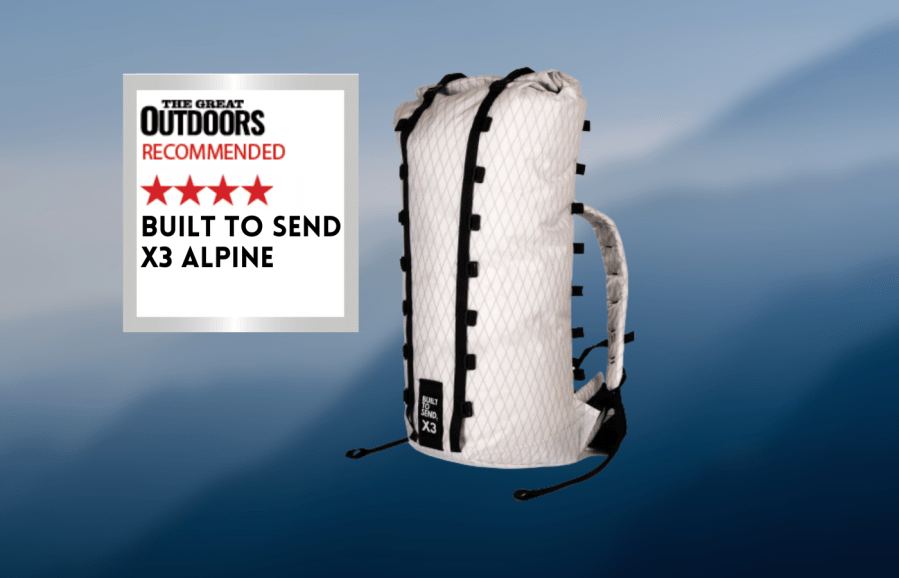
Chris Townsends verdict
As the name suggests the X3 Alpine is designed for mountaineering rather than backpacking but it works well for the latter. I did find I had to adapt my packing techniques but once I did I enjoyed it- Durability
- Comfort
- Stability
- Low weight
- No external pockets
- Only One Size
- Expensive
| Quick specs | |
|---|---|
| Price: £319 Weight: 1.235kg with straps & shockcord Capacity: 50-65 litres Materials: expedition-grade VX42 X-Pac composite fabric Closure: fold over top with twin straps Back: 10mm thick physically cross-linked polyethylene foam pad Hipbelt: 10mm polyethylene foam, slightly shaped Pockets: 1 internal zipped Features: Detachable side compression straps, shockcord and ice axe loops Sizes: 1 Women’s/Men’s Version: no URL: https://www.builttosend.com/ |
The X3 Alpine is a minimalist backpacking pack designed by Built To Send, known for its durability and versatility. Made from a tough fabric, it can carry any weight and has no external features except for daisy chain webbing and webbing loops. The pack comes with an “Alpine Customisation Pack” which includes webbing straps, shock cord, and loops for ice axes. It has a fold-over top with straps and hooks, and a volume of 50-65 litres. The non-adjustable back system is basic, with no frame, load lifter straps, or scapular or lumbar pads. The pack has a simple padded back, shoulder straps, and hipbelt, covered by the same fabric as the rest of the pack. Although designed for mountaineering, the X3 Alpine works well for backpacking. Built To Send does not offer accessories beyond the shockcord and straps, but pockets from other companies can be added if needed.
Read Chris Townsend’s full Built To Send X3 Alpine Backpack Review
Granite Gear Crown 3 60
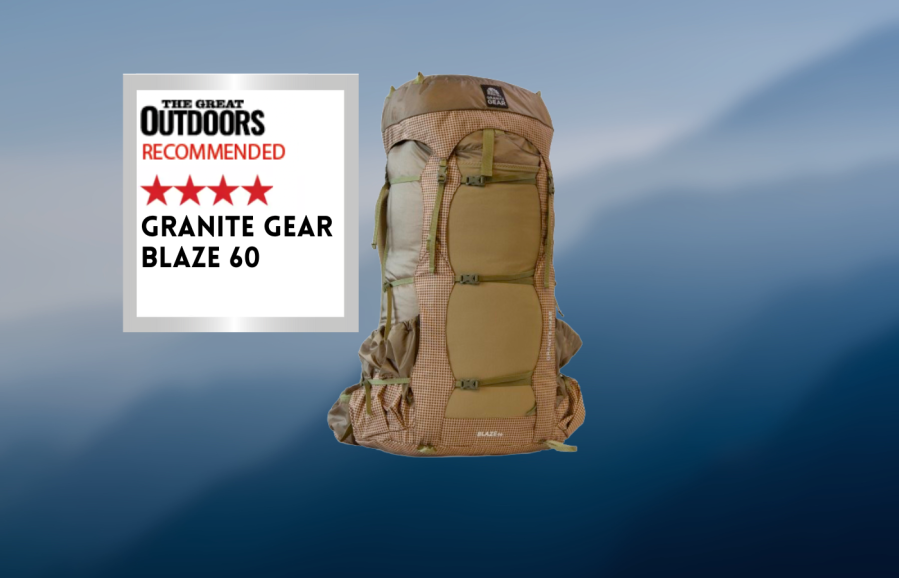
Chris Townsend recommends
The Crown 3 60 is lightweight but not so light that it feels flimsy or has tiny fiddly components. For backpacking it should last. Unless you’ll be carrying very heavy loads it’s an excellent choice- Adjustable hipbelt
- Compression straps
- Pockets
- Low weight
- tall and narrow with only top access
| RRP: $220 | £190 Weight: 1290g (regular) Capacity: 60 litres Materials: 100D & 210D high tenacity nylon Closure: detachable lid, roll-top Back: compression moulded polyethylene framesheet, moulded foam panel Hipbelt: adjustable dual density foam Pockets: zipped lid, 2 drawcord-closed side, stretch mesh front, 2 zipped hipbelt Features: side compression straps, front compression straps, ice axe/trekking pole loops, loops on the base for attaching cord | Sizes: short, regular, long Women’s version: yes |
The Granite Gear Crown 3 60 pack is a lightweight, comfortable, and lightweight option for backpacking. It weighs 1290g (regular) and has a capacity of 60 litres. The pack is made of 100D & 210D high tenacity nylon, with a detachable lid and roll-top closure. The hipbelt is adjustable for fit, and the shoulder straps are well-padded. The harness system is more comfortable than many lightweight packs, making it suitable for scrambling and rough terrain.
The pack has plenty of pockets, including a front stretch mesh pocket for waterproofs, solid fabric side pockets for litre-sized water bottles, and a spacious lid pocket. The floating lid is removable and has a buckle-fastened roll top for easy access. The front and side compression straps make it easy to attach bulky items.
The Crown 3 60 is lightweight but not flimsy or has tiny fiddly components. It should last well for backpacking and is an excellent choice unless carrying heavy loads. The pack can be used as a chest pack or lumbar pack with the pack hipbelt, saving 100 grams of weight.
This backpack is The Great Outdoors‘ ‘Best Buy’ – one of the best backpacking packs on the market. Read Chris’ full review of the Granite Gear Crown 3 60.
Mountain Laurel Designs Exodus 55L

Francesca Donovan Recommends
I was sceptical about frameless packs but found the weight-saving measures and stabilising straps resulted in a comfortable carry.- Lightweight
- Excellent construction
- Sizing options
- Cost of personalisation
| Quick specs | |
|---|---|
| RRP: $245/£199.15 (plus additional costs for optional add-ons) Weight: 596g (size medium, inc. additional sternum strap, 10″ of black 1/8″ bungee cord, 2 mini cord clips and 3 cord locks) Capacity: 55l Materials: UltraGrid 200d RipStop Closure: roll top Back: frameless Hipbelt: Large padded lightweight DX 210D Black Ripstop hip-belt wings (separate from shoulder strap so can be cut off) with 1″ webbing and optional removable hip pockets Pockets: main compartment Features: seam taped construction, curved side panels move load closer to upper back Sizes: M – XL Men’s version: unisex |
The Mountain Laurel Designs Exodus 55l backpack is a lightweight, abrasion-resistant pack with a 596g capacity. It is made of UltraGrid 200d RipStop material and features a roll-top closure, frameless back, and large padded hipbelt wings. The pack is lightweight, with breathable padding on the back and hip belt. The roll-top design is simple to use and can be expanded or compressed for more or less gear. The pack is durable with double or triple-stitched seams and 60 strategically placed bartacks. It is waterproof, but dry bags are recommended for compartmentalization. Sizing is limited, and the Prophet 48l is recommended for hikers under 5’6″. However, this weight-saving feature results in an easy and balanced carry.
Read Francesca’s Mountain Laurel Designs Exodus 55l review
Sierra Designs Gigawatt 60L
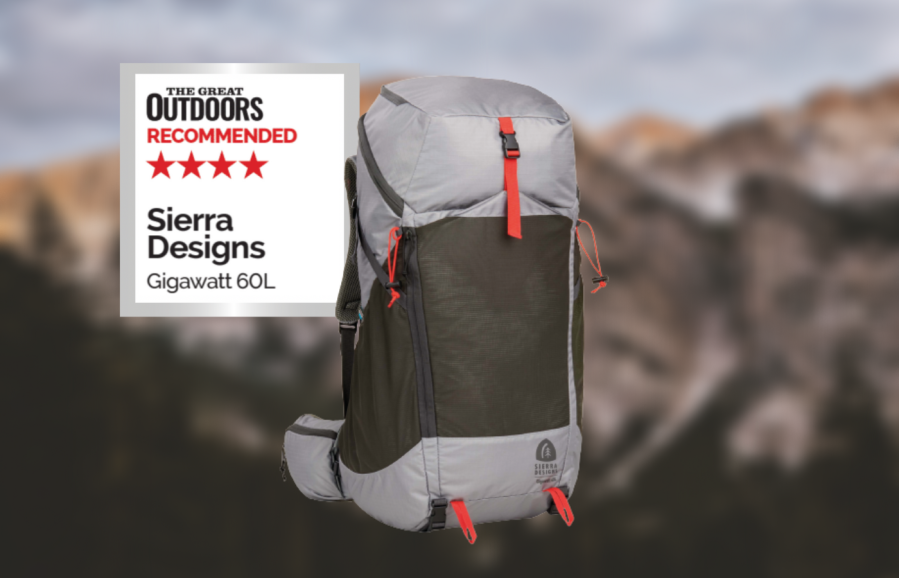
TGO Magazine verdict
- Easy access
- Pockets
- Cost
- Non-adjustable closure
- Weight
| Quick specs | |
|---|---|
| RRP: $149.95 | £130 Weight: 1830g Capacity: 60 litres Materials: 300 x 400D polyester ripstop Closure: zip-round top, side zip Back: perimeter frame, framesheet, padded panel Hipbelt: padded, shaped Pockets: zipped lid with inner compartment, 2 stretch mesh side, stretch mesh front, 2 zipped hipbelt Features: side compression straps, base straps, ice axe/trekking pole loops, internal hydration sleeve Sizes: one, adjustable for torso 16-21 inches (40-53cm) Women’s version: unisex |
The Sierra Designs Gigawatt 60l is a lightweight, compact pack that comes in one size and features an adjustable back. The shoulder straps attach to a flat panel with Velcro, allowing for easy adjustment. The pack has back length markings from 16 inches to 21 inches, and the shoulder straps are firm and soft. The hipbelt is thick and soft, making it comfortable for carrying loads up to 20kg. The pack has a large curved top opening and a long side zip, but the top opening cannot be cinched down if the pack isn’t full. The pack has six spacious pockets, one large enough for a wet tent and the other for litre water bottles. The single compression straps on each side make attaching items difficult, but there are straps on the base for foam pads. Although there are lighter packs available, the Gigawatt is an excellent choice for its price.
Read Chris’ full review of the Sierra Designs Gigawatt 60L.
Granite Gear Blaze 60

Chris Townsend Recommends
The Blaze is a lightweight functional pack. I like it a great deal. It is quite expensive though.- Comfy
- Pockets
- Front Zip
- 3 sizes
- Expensive
| Quick specs | |
|---|---|
| Price: £294.99 Weight: 1.43kg (Regular) Capacity: 60 litres Materials: 210 D Robic nylon UHMWPE triple ripstop Closure: removable, extendable lid, front zip Back: adjustable, moulded framesheet, moulded foam back panel Hipbelt: shaped, adjustable Pockets: stretch front, lower side water bottle, 2 zipped hipbelt, zipped lid Features: side compression straps, front compression straps, ice axe loops Sizes: short, regular, long Women’s/Men’s Version: no URL: https://www.granitegear.com |
The Blaze backpacking pack, a popular choice from Granite Gear, has undergone significant improvements in recent years. The latest version features a side zip for easy access to contents and a buckled lid instead of a long rollover top. The pack has an adjustable shoulder harness and well-padded hipbelt, and can carry up to 22.7 kg. It also features a long stretch pocket on the front for wet tents or waterproofs, roomy side pockets with stretch drawcord closures, and a spacious lid pocket. The pack can be closed with a drawcord, strap, and buckle. The long zip at the side of the front pocket is useful for accessing non-top contents. The pack also has three compression straps for easy compression around the load. Despite its lightweight and functional nature, the Blaze is quite expensive.
Read Chris Townsend’s full Granite Gear Blaze 60 Backpack Review
Big Agnes Garnet 60l
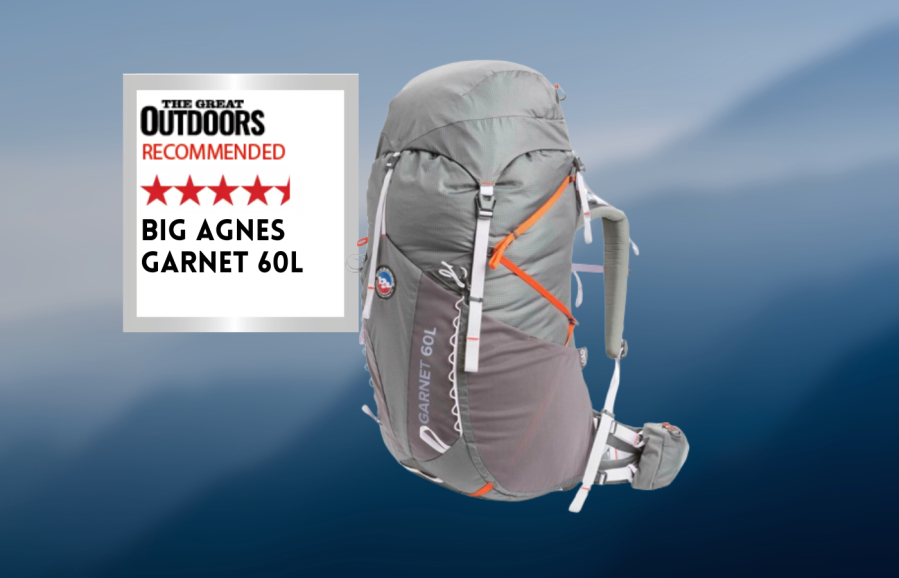
Fiona Russell Recommends
The pack is very well made and with good quality materials, including “Mipan regen”, which is a GRS-certified 100% recycled nylon.- Female fit
- Adjustability
- comfort
- Eco Fabric
- Hipbelt
- Rain cover, exrtra cost
- Small Clips
| Quick specs | |
|---|---|
| Price: £259.99 Weight: 1740g Capacity: 60 litres (plus 7 litres) Materials: 100% recycled high tenacity nylon, dual density foam, twill fabric base, nylon taffeta lining Closure: detachable lid, drawstring “spindrift” collar Back: internal aluminum perimeter frame, curved back panel with body mapped foam Hipbelt: double adjustable, articulated, foam Pockets: 2 zipped in lid, bladder sleeve, 2 side and 1 rear stretch mesh, zipped rear, 2 zipped hipbelt Features: three torso length adjustments, sternum strap, side compression straps, 2 trekking pole web and bungee cord loops, daisy chain loops, bottom lash loops, top grab handle, loops on the base for attaching cord Sizes: one Women’s/Men’s Version: 63l Parkview URL: https://www.bigagnes.com/ for UK sales: www.ultralighoutdoorgear.co.uk |
The Big Agnes Garnet backpack is made of high-quality materials, including GRS-certified 100% recycled nylon, and is designed for women. It features a female-specific design with three height adjustments, a padded back, contoured shoulder straps, an anatomical hip belt, and dual stabiliser. The backpack has plenty of packing space, including a large main compartment with a top drawstring opening, which can be enlarged to 67 litres. However, there is no divider or lower zipped compartment, making it difficult to find items. The backpack has a range of pockets, including zipped pockets on the detachable lid, two roomy hipbelt pockets, and a rear zipped pocket. The zip pulls are large and easy to use, but the clips feel flimsy compared to the nylon fabric. The lilac-colored straps and detailing are easy to dirty. The added “trash” sack on the side of the pack is removable as it flaps annoyingly.
Read Fiona’s full Big Agnes Garnet 60l Backpack Review
Osprey Exos Pro 55
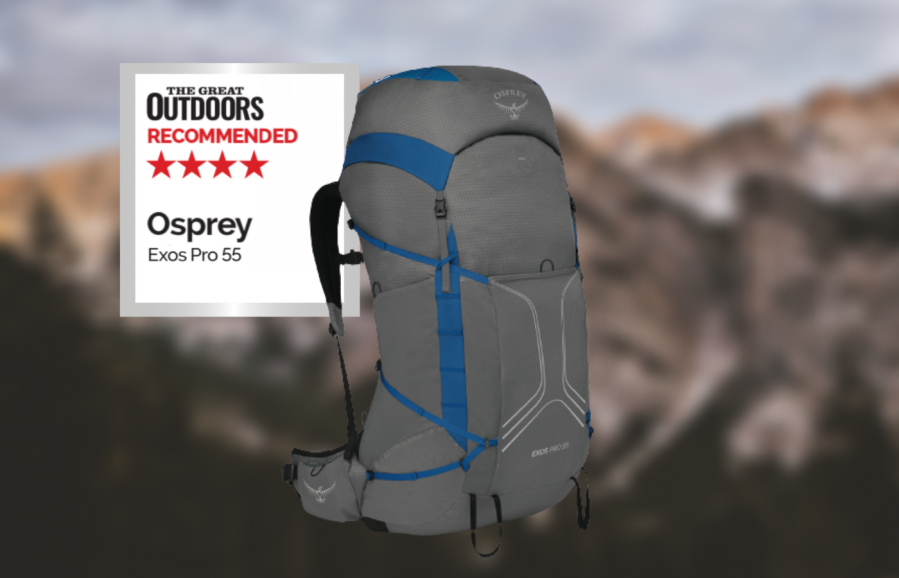
Chris Townsend recommends
For backpackers looking to cut weight, the Osprey Exos Pro 55/Eja Pro 55 is excellent.- Ultralight
- Adjustability
- Sizes & Pockets
- Expensive
- Limited load capacity
| Quick specs | |
|---|---|
| RRP: $289.95 | £230 (Available from Osprey) Weight: 950g (S/M) Capacity: S/M 55 litres, L/XL 58 litres Materials: 100D Nylon x 200D UHMWPE (ultra-high-molecular-weight polyethylene) ripstop Closure: detachable lid, buck Back: wire frame, tensioned mesh panel Hipbelt: padded, shaped Pockets: zipped lid, 2 stretch mesh side, stretch mesh/fabric front, zipped hipbelt, zipped open top hipbelt Features: side compression straps, ice axe/trekking pole straps, inner hydration sleeve, front and lid attachment loops Sizes: men S/M, L/XL, women (Eja Pro) WXS/S, WM/L Women’s Version: Eja Pro |
The Osprey Exos Pro 55, weighing less than a kilo, is an ultralight backpacking pack with features similar to the heavier Exos 58. It is made of 100D Nylon x 200D UHMWPE ripstop and has a curved back with a tensioned mesh panel to reduce sweat build-up. The pack comes in two men’s and two women’s sizes and has a ladder system for up to 10cm of adjustment in each size. The fabric is bluesign approved and has a non-PFC DWR treatment. The pack has two closure options: a removable floating lid and a fixed flap. The six pockets are roomy, with side pockets having top and side access for water bottles, and the front pocket is solid fabric with mesh side panels. The pack has double compression straps on each side and four lash loops on the lid and ten on the front. The pack is suitable for backpackers looking to cut weight, with the Eja Pro55 for women.
Read Chris Townsend’s full Osprey Exos Pro 55 review.
Lowe Alpine Women’s Sirac ND65L Trekking Pack
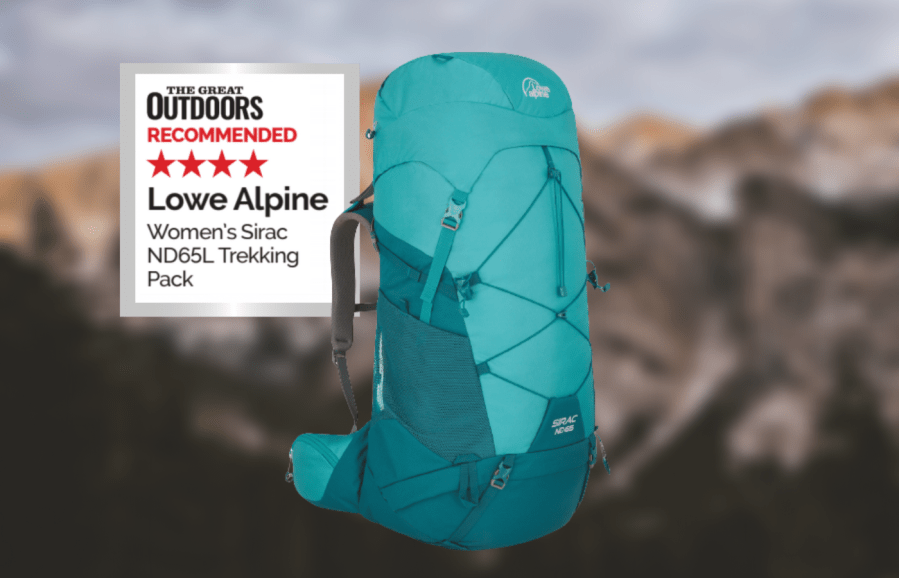
Francesca Donovan Recommends
This is a well-designed, comfortable and affordable pack capable of carrying fuller loads on longer treks.- Freedom of movement
- Ventilation
- Weight
- Small hip pockets
| Quick specs | |
|---|---|
| RRP: $200 | £150 Weight: 1918g Capacity: 65l Materials: 50% recycled 420D Dobby and 100% recycled 600D PW / HydroShield Closure: drawcord with clipped lid Back: Adjustable Air Contour™ X carry system Hipbelt: Air Contour™ X hipbelt with floating pockets Pockets: Dual access main compartment with removable divider separating lower sleeping bag compartment, zipped lid, two side stretch mesh pockets, elastic front stash, internal hydration sleeve, lash points, floating hipbelt pockets, integrated raincover pocket | Features: narrow design, elastic front stash Sizes: One size (back length: 17-19″ / 43-48cm) Men’s version: Yes |
The Lowe Alpine Women’s Sirac is a comfortable, backpacking pack with a narrow fit, allowing for good upper body movement and balance across rough terrain. The pack features an adjustable Air Contour™ X carry system, a dual access main compartment, a removable divider, a zipped lid, two side stretch mesh pockets, an elastic front stash, an internal hydration sleeve, lash points, floating hipbelt pockets, and an integrated raincover pocket. The pack also has a raincover which i made good use of in light showers.
The main body of the pack can be split into two, with the bottom of the pack easily accessible by a covered zip pocket. The pack offers a removable divider, mesh side pockets, a hydration sleeve, an elastic front stash, additional lash points, and pole attachment points. The hip pockets are somewhat stingy, but the lid is generous and can add extra height. Overall, the Lowe Alpine Sirac is a well-designed, comfortable, and affordable pack capable of carrying fuller loads on longer treks.
Read Francesca’s full Lowe Alpine Women’s Sirac ND65L review
Big Agnes Parkview 63L
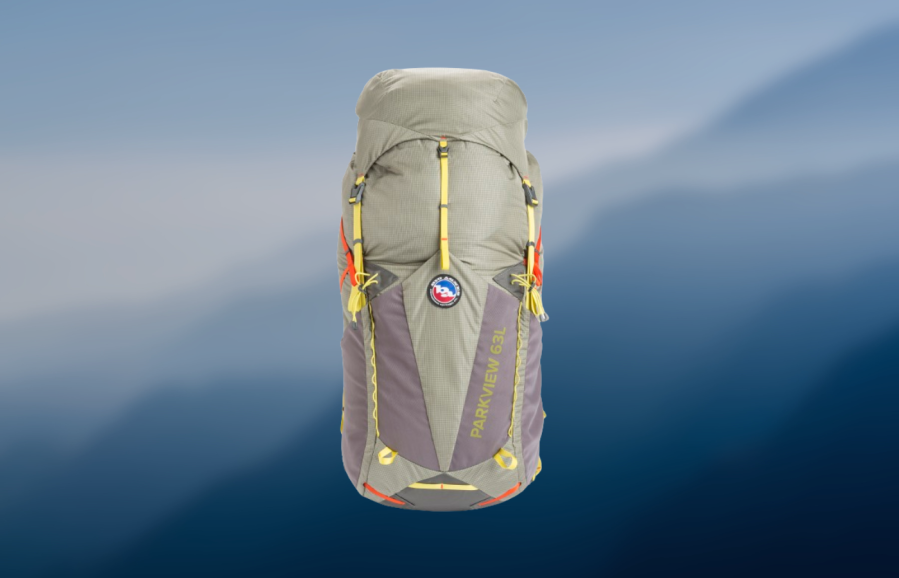
Chris Townsend’s verdict
Overall the Parkview is a good pack but it is quite heavy.- Hipbelt
- Pockets
- Recycled fabric
- Litter bag
- Lid Extension
- Straps too short
- Heavy
| Quick specs | |
|---|---|
| Price: £259.99 Weight: 1.85kg (medium) Capacity: 63 + 10 litres Materials: recycled high-tenacity Mipan® regen Robic nylon Closure: detachable lid Back: perimeter frame, moulded framesheet, foam panel Hipbelt: shaped, with cut-outs Pockets: 1 stretch front, 1 zipped front, 2 zipped hipbelt, 1 zipped lid, 1 internal lid Features: side compression straps, ice axe loops, 7 litre litter/rubbish bag Sizes: medium, large Women’s/Men’s Version: yes (women’s the Garnet 60L) URL: https://www.bigagnes.com |
The Parkview backpacking pack is a unique and comfortable option for winter backpacking. It features an adjustable shoulder harness, hipbelt with cutouts and dual stabiliser straps, and firm foam padding. The integrated system ensures balance on uneven terrain and pulls the load into the body when tightened. The pack can handle up to 23kg and is stable on rough snowy ground. The pack bag has ample roomy pockets, including a zipped mesh pocket for maps and small items, and lid pockets. The hipbelt pockets are detachable and don’t flatten when tightened. A separate drawcord-closed bag called Trash Can is included for litter found on walks. The lid is extendable and detachable, but the rear straps are short. The pack’s weight may be a concern, but it is a good choice for those looking for a lightweight option.
Read Chris Townsend’s full Big Agnes Parkview 63L Backpack Review
Of course, even the best backpacking packs do need some TLC, especially after heavy use. Find out how to clean your backpack and how to re-proof your backpack so they’ll last as long in the hills as you.
How we test
Chris Townsend
Chris Townsend tested these packs in the Scottish Highlands on backpacking trips from spring 2023 to winter 2024 in all weather conditions. The packs were weighed on Chris’s digital scales.
Francesca Donovan
Francesca tested these packs on a number of overnight backpacking routes with plenty of ascent and rough terrain in snow, rain and high winds, as well as unseasonably milder days in the Southern Uplands, Eryri (Snowdonia), the Lake District and the Peak District, throughout late winter and spring 23.
Fiona Russell
Fiona is 5ft 8in and a slim build. She has tested the packs on trails and hills when filled with enough kit for a couple of days of walking and an overnight wild camp. The packs were weighed on digital scales.
Key features of the best backpacking packs
Capacity
Check all your gear will fit inside and take the stated capacity as approximate only. Where two figures are given the first is usually the key one, the second often refers to the inner extended as far up as it will go, which can make for an unstable load. Some companies include pocket volume in the overall figure, but most don’t.
Weight
A rough rule of thumb is that the empty pack shouldn’t weigh much more than 10% of the total weight you’ll be carrying. This includes food and water, not just gear.
Back Length
The pack must be the correct length for your torso. Trying on a loaded pack is the best way to check this.
Back System
A pack for heavy loads should have a fairly stiff frame to help transfer the load to your hips. Padding or mesh that holds the frame away from the back adds comfort but also increases instability on more technical ground.
Hipbelt
Hipbelts should fit snugly around the hips. Thickly padded belts with some form of stiffening are better for heavy loads. Curved belts stay in place better than straight ones.
Pockets/Compartments
Pockets are useful for organising gear, especially small items that might be needed during the day. Lower compartments can be useful for sleeping bags. Mesh pockets are useful for wet items, allowing them to drain and dry out. Large ones can even be used for tents.
Lids/Closure
A lid should fit closely over the biggest load. Some can be extended to do this, some just stretch, which can have limits. Detachable (aka ‘floating’) lids can cover items such as foam pads or a climbing rope carried above the main pack body.
Straps
External straps can be used for attaching items such as foam pads or trekking poles and for compressing the size of the pack when a small load is carried. Straps should be easy to adjust and shouldn’t interfere with access to pockets.
Rain covers
Packs are usually made of water-resistant materials, but the seams aren’t sealed and can leak so sensitive gear needs protecting from rain. Many packs come with waterproof covers. Covers can blow off or tear and don’t fit properly over trekking poles. You have to remove the cover to access the contents too, which is not ideal in the rain. Pack liners or dry bags are a more secure option for keeping your kit dry.

